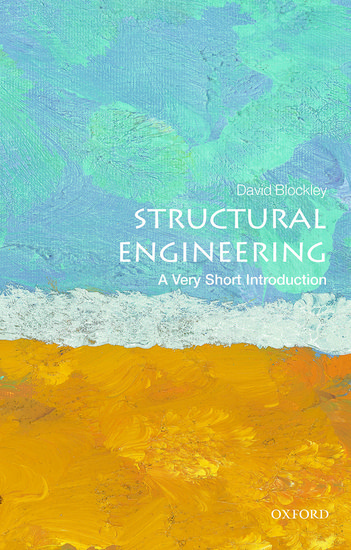Home >
A Very Short Introduction >
Structural Engineering (Architecture)
A Very Short Introduction | Architecture
Structural Engineering
ISBN: 9780199671939
Series: A Very Short Introduction
Structural Engineering (Architecture)
A Very Short Introduction Structural Engineering (Architecture) Media > Books > Non-Fiction > Education Books Expect Delays of Up to 4 Weeks| Order Below |
ISBN
9780199671939 (10-digit ISBN: 0199671931)
- Description
- Key Features
- Series Description
- Table of Contents
- Looks at what structural engineering is and how it fits into other branches of engineering
- Examines the close relationship between architectural and structural form
- Explores how structures work including issues such as safety and logistics
- Considers its affects on the material world around us
- Includes a number of different structures from civil, mechanical, aeronautical, and aerospace engineering
Have you ever wondered how it's possible to build a skyscraper, a big bridge, a jumbo jet, or a cruise liner?
Everything has structure. Structure is the difference between a random pile of components and a fully functional object. Through structure the parts connect to make the whole. Natural structures vary from the very smallest part of an atom to the entire cosmology of the universe. Man-made structures include buildings, bridges, dams, ships, aeroplanes, rockets, trains, cars and fair-ground rides and all forms of artefacts, even large artistic sculptures. The wide range of different industries in which structural engineers work includes construction, transport, manufacturing, and aerospace.
In this Very Short Introduction, David Blockley explores, in non-technical language, what structural engineering is all about, including examples ranging from the Shard in London and the Golden Gate Bridge in San Francisco to jumbo jets like the A380 and the Queen Elizabeth cruise liner.
Oxford's Very Short Introductions series offers concise and original introductions to a wide range of subjects--from Islam to Sociology, Politics to Classics, Literary Theory to History, and Archaeology to the Bible.
Not simply a textbook of definitions, each volume in this series provides trenchant and provocative--yet always balanced and complete--discussions of the central issues in a given discipline or field. Every Very Short Introduction gives a readable evolution of the subject in question, demonstrating how the subject has developed and how it has influenced society. Eventually, the series will encompass every major academic discipline, offering all students an accessible and abundant reference library.
Whatever the area of study that one deems important or appealing, whatever the topic that fascinates the general reader, the Very Short Introductions series has a handy and affordable guide that will likely prove indispensable.
Please note: As this series is not ELT material, these titles are not subject to discount.
1: Everything has structure
2: Does form follow function?
3: From Stonehenge to skyscrapers
4: Understanding structure
5: Movers and shakers
6: Resilience
Glossary
References
Further reading
Index
Have you ever wondered how it's possible to build a skyscraper, a big bridge, a jumbo jet, or a cruise liner?
Everything has structure. Structure is the difference between a random pile of components and a fully functional object. Through structure the parts connect to make the whole. Natural structures vary from the very smallest part of an atom to the entire cosmology of the universe. Man-made structures include buildings, bridges, dams, ships, aeroplanes, rockets, trains, cars and fair-ground rides and all forms of artefacts, even large artistic sculptures. The wide range of different industries in which structural engineers work includes construction, transport, manufacturing, and aerospace.
In this Very Short Introduction, David Blockley explores, in non-technical language, what structural engineering is all about, including examples ranging from the Shard in London and the Golden Gate Bridge in San Francisco to jumbo jets like the A380 and the Queen Elizabeth cruise liner.
Key Features
- Looks at what structural engineering is and how it fits into other branches of engineering
- Examines the close relationship between architectural and structural form
- Explores how structures work including issues such as safety and logistics
- Considers its affects on the material world around us
- Includes a number of different structures from civil, mechanical, aeronautical, and aerospace engineering
Series Description
Oxford's Very Short Introductions series offers concise and original introductions to a wide range of subjects--from Islam to Sociology, Politics to Classics, Literary Theory to History, and Archaeology to the Bible.
Not simply a textbook of definitions, each volume in this series provides trenchant and provocative--yet always balanced and complete--discussions of the central issues in a given discipline or field. Every Very Short Introduction gives a readable evolution of the subject in question, demonstrating how the subject has developed and how it has influenced society. Eventually, the series will encompass every major academic discipline, offering all students an accessible and abundant reference library.
Whatever the area of study that one deems important or appealing, whatever the topic that fascinates the general reader, the Very Short Introductions series has a handy and affordable guide that will likely prove indispensable.
Please note: As this series is not ELT material, these titles are not subject to discount.
EASY ORDER FORM
PRICES LISTED INCLUDE CONSUMPTION TAX
Price Before Tax:
¥1,790


